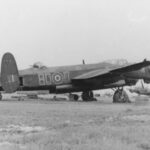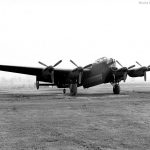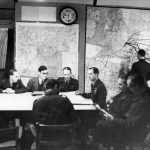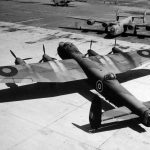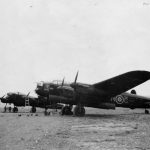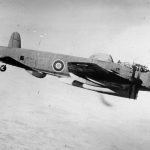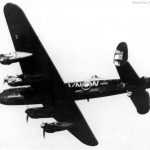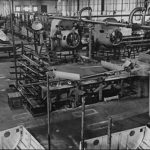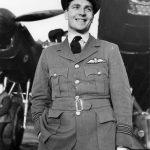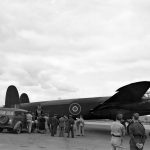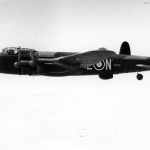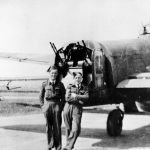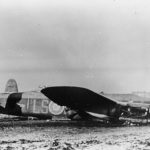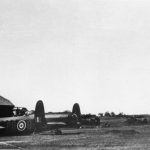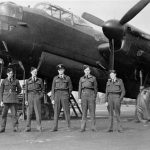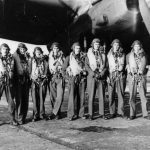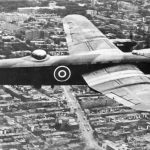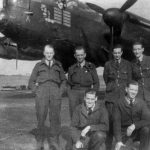Lancaster Mk III LL796 BQ-D of No. 550 Squadron RAF
1000th “Lanc” made at Metro-Vick
Production line Metro-Vick, Trafford Park
Pathfinder planning at HQ Wyton with Air Vice Marshal Don Bennett
Lancaster W4964 WS-J “Still Going Strong” ofter 104 operations
Lancaster W4783 AR-G of No. 460 Squadron RAF
Lancaster W4275 SR-C of No. 101 Squadron RAF, Ludford Magna
Crew with Lancaster W4783 AR-G of No. 460 Squadron RAF 1942
Lancaster W4236 QR-K of No. 460 Squadron RAF, Syerston June 1943
Lancaster W4154 of No. 1667 Heavy Conversion Unit RAF
Lancaster in USA
Lancaster VN-N of No. 50 Squadron RAF in flight
Lancaster VN-K of No. 50 Squadron RAF, Old King Cole
Lancaster SR-E2 of No. 101 Squadron RAF, Ludford Magna July 43
Lancaster test dropping a 12000lb HC bomb
Lancaster “The Saint” W4367 ZN-C of No. 106 Squadron RAF
Lancaster TW659 TL-M of No. 35 Squadron RAF, New York July 1946
Lancaster RO-Q of No. 61 Squadron RAF
Lancaster ASR Mk III RF324 of No. 279 Squadron RAF with airborne lifeboat
Lancaster ASR Mk III RF324 of No. 279 Squadron RAF dropping lifeboat
Lancaster ASR Mk III RF324 of No. 279 Squadron RAF with airborne lifeboat 1945
Lancaster RF141 coded JO-U of No. 463 Squadron RAAF
Lancaster R5852 OL-Y of No. 83 Squadron RAF 1942
Lancaster R5845 YW-T 1660 Heavy Conversion Unit Winthorpe, Ocrober 1943
Avro Lancaster R5845 1660 Heavy Conversion Unit Winthorpe, Ocrober 1943
50 Squadron aircrew in front of a Lancaster R5689 VN-N 1942
Lancaster R5689 of No. 50 Squadron RAF
Lancaster R5689 of No. 50 Squadron RAF 1942
Lancaster RF141 “Uncle Joe Again” of No. 463 Squadron RAAF
Lancaster R5546 VN-T of No. 50 Squadron RAF August 1943
Lancaster R5546 VN-T of No. 50 Squadron RAF
Lancaster QR-O of No. 61 Squadron RAF
Lancaster PO-N of No. 467 Squadron RAAF over target 10 September 1944
Lancaster Production Armstrong Whitworth
Lancaster pilot W/Cdr James F Barron, June 1943
Lancaster pilot S/Ldr John Searby of 83 Squadron RAF
Lancaster PD328 of Empire Central Navigation School at RNZAF Station Whenuapai
Lancaster PD235 UL-N of No. 576 Squadron RAF
F/Lt John White crew 2
S/Ldr Oldacre with crew, 1945
Lancaster PB821 50 Sqn at Skellingthorpe
Lancaster PB293 EM-W of No. 207 Squadron RAF August 1944
Lancaster PA280 9J-P of No. 227 Squadron RAF at Strubby 27 April 1945
Lancaster PA280 9J-P of No. 227 Squadron RAF at Strubby 27 April 1945
Lancaster PA170 LS-N of 15 Sqn, 4 December 1944 at Juvincourt
Lancaster Mk I FE TW911
Lancaster NG347 QB-P “Princess Pat” No. 424 Squadron RCAF 1945
Lancaster TC-E “Olivia” of No. 170 Squadron RAF
Lancaster ME746 No. 166 Squadron RAF at Kirmington after 116 Ops
Lancaster ME739 crew in their flying suits
Lancaster LM420 PG-R “Pistol Packin Rosita” nsoe art, Summer 1944
Crashed Lancaster LM310 PO-O at Coltishall 1943
Lancaster LL845 WS-L of No. 9 Squadron RAF at Bardney January 1945
S/Ldr Richardson with Lancaster LL842 VN-F “Phyllis Dixey” May 1944
Lancaster crew posing beside their bomber
Lancaster LL842 VN-F No. 50 Squadron RAF at Skellingthorpe
Lancasters KC-B NG494, YZ-B PD114 and YZ-J PD119 of No. 617 Squadron RAF, 1945
83 Squadron aircrews posing with Lancaster III JB114
Lancaster KB700 “Ruhr Express” of of No. 419 Squadron, RCAF
Crew and Lancaster “Hilda” No. 83 Squadron RAF
Lancaster ED888 crew posing beside their bomber
Lancaster ED655 DX-X No. 57 Squadron RAF at Scampton June 1943
Lancaster ED433 KM-V of No. 44 Squadron RAF 1943
Lancaster named “Dumbo” PG-D of No. 619 Squadron RAF at Strubby, Winter 1943/44
Lancaster crew of 15 Sqn on return from a raid on “Adrimal Scheer” at Kiel, 7 April 1945
Lancaster named “Dumbo” of No. 619 Squadron RAF at Strubby, Winter 1944
Lancaster WS-N of No. 9 Squadron RAF
Crew posing with Lancaster of No. 97 Squadron RAF at Coningsby
Lancaster of No. 83 Squadron RAF, October 1942 at Wyton
Pathfinder Lancaster of No. 7 Squadron RAF at Oakington
Crew with Lancaster CF-G of No. 625 Squadron RAF 1944
Crews of 5 Group after raid Milan 24 October 1942
617 Squadron Dambusters with Nick Knilans
Goundcrew with Lancaster 57 Sqn at Scampton Erks 1943
F/Lt T.B. Cole in cockpit of Lanc
Lancaster of No. 50 Squadron RAF at Skellingthorpe
F/O Wickes crew
No. 405 Squadron RCAF Crew with Lancaster at Gransden Lodge
Lancaster KM-Y of No. 44 Squadron RAF
W/Cdr John Bernard Nicholls with crew
Lancaster 35 Sqn PFF WCdr Nicholls 45
Lancaster crew after 25 ops, No. 97 Squadron RAF at Coningsby
207 Squadron crew 1944
Lancaster 1945
Lancaster No. 12 Squadron RAF at Wickenby April 1943
Lancasters of No. 5 Group at Le Creusot daylight raid, 17 October 1942
Lancasters at Blida July 43
Lancasters ED860 QR-N and ED588 VN-G 1943
Lancaster JA967 No. 44 Squadron RAF
Lancasters No. 83 Squadron RAF at Wyton 22 October 1942
Lancasters of No. 617 Squadron RAF taxying at Blida 1943
Lancasters 463 Sqn at Waddington 01 March 1944
Lancasters of No. 149 Squadron RAF at Methwold
Avro Lancaster I
crews after briefing, 83 Squadron at Scampton 1942
Formation of Lancasters 35 Sqn
Avro Lancaster of No. 35 Squadron RAF
582 Sqn Pathfinder Bombs, 19 July 1944
576 Squadron F/O B H O’Neil and crew 1945
576 Squadron ground crew in front of Lancaster UL-A at RAF Station Fiskerton
576 Squadron Lancaster UL-N ME801 at Fiskerton
35 Squadron Canadian Pathfinder S/Ldr Reg Lane with crew and Lancaster KB700 15 September 943
106 Squadron crews, Guy Gibson and Lancaster ED593 Admiral Prune II, 1942
Avro Lancaster, a British four-engined heavy bomber used during World War II. Below is a structured summary of the key details:
Type
- Four-engined Heavy Bomber
Wings
- Design: Mid-wing cantilever monoplane with a five-section structure.
- Construction: Two-spar structure with extruded aluminum-alloy components and a smooth aluminum-alloy skin. Detachable sections for maintenance and assembly ease.
- Control Surfaces: Ailerons (with trimming-tabs) and split trailing-edge flaps.
Fuselage
- Structure: Oval all-metal, comprising five main sections. It includes pairs of extruded longerons supporting a smooth skin plating and integral bomb compartment.
- Construction: Combination of “U”-frames, formers, and longitudinal stringers covered with flush-riveted metal skin.
Tail Unit
- Design: Cantilever monoplane with twin oval fins and rudders.
- Construction: Similar to wings, with metal-covered tail-plane, fins, and rudders. Fabric-covered elevators with trimming-tabs.
Landing Gear
- Configuration: Retractable main wheels into engine nacelles, fixed tail-wheel. Track width is 23 ft. 9 in. (7.24 m.).
Power Plant
- Engines:
- Lancaster I & III: Rolls-Royce Merlin XX or Packard-built Merlin 28, 12-cylinder Vee liquid-cooled engines, each producing 1,280 hp.
- Lancaster II: Bristol Hercules, 14-cylinder two-row radial air-cooled engines, producing 1,600 hp.
- Propellers: Three-bladed, constant-speed, full-feathering.
- Fuel System: Six protected fuel tanks in wings, separate oil tanks in each nacelle.
Accommodation
- Crew: Seven members with specific stations for bomb-aimer, pilot, fighting controller, navigator, radio operator, and gunners.
- Features: Walkway along the fuselage, rest room with bed, and main entrance door on starboard side.
Armament and Equipment
- Guns: Ten Browning .303 machine guns in four hydraulically-operated turrets.
- Bomb Load: Maximum 18,000 lbs (8,170 kg) normal, up to 22,000 lbs under special conditions.
- Protection: Armored sections and bullet-proof glass, especially around the pilot and vital components.
- Additional Equipment: Night-flying equipment, radio, oxygen, de-icing, and emergency dinghy.
Dimensions
- Wingspan: 102 ft. (31.1 m)
- Length: 69 ft. 4 in. (21.1 m)
- Height: 20 ft. (6.1 m)
- Wing Area:
- Net: 1,205 sq. ft. (112 sq. m)
- Gross: 1,297 sq. ft. (120.5 sq. m)
Weights and Loadings
- Empty Weight: 37,000 lbs. (16,750 kg)
- Maximum Bomb Load: 18,000 lbs. (8,170 kg)
- Normal Loaded Weight: 68,000 lbs. (30,800 kg)
- Wing Loading: 52.7 lbs./sq. ft. (258 kg./sq. m.)
- Power Loading: 13.3 lbs./hp (6.35 kg./hp)
Performance
- Maximum Speed: 275 mph (440 km/h)
- Maximum Range: Approximately 3,000 miles (4,800 km)
These specifications highlight the Lancaster’s design focus on heavy payload capacity, versatility in armament, and operational range, making it a crucial asset in Allied strategic bombing campaigns.
